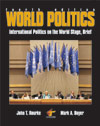The most recent well-publicized effort to advance
women's rights globally was the fourth World Conference on Women
(WCW) that convened in Beijing in September 1995. Building on the
third conference, held in Nairobi in 1985, and also on other events
such as the 1994 UN Conference on Population and Development (UNCPD)
held in Cairo, the WCW had three "priority themes": equality
(especially equal pay for equal work), development (with an emphasis
on population, nutrition, and health factors), and peace (particularly
eradicating societal and family abuse of women). The 188-page report that emerged from the WCW declared
that women have the right to decide freely on all matters related
to their sexuality and child-bearing. This included a condemnation
of forced sterilizations and abortions. The final document denounced
rape in wartime as a war crime and called on national governments
to intervene to prevent the genital mutilation of girls, bride burning,
and all spousal abuse. The conference also called for the economic
empowerment of women. To this end, it demanded an end to sexual harassment
at work. The document further called for public and private lending
organizations to extend credit to low-income women for establishing
small businesses and other economic betterment projects and for an
end of forbidding women to inherit their husband's property (Scott,
1996). There were, of course, controversies. The ongoing sensitivities
of some Roman Catholic, Muslim, and other countries to the issue of
abortion led to language in the final document that was not as strong
as some abortion-rights advocates wished. Lesbian rights were debated
internationally for the first time, but no language was included in
the report. In many ways, though, the specifics about what the conference
said are less important than the fact that it happened and that it
voiced the concerns of women and presented their goals to a global
audience. The official conference at Beijing was attended by some
3,000 delegates from 180 countries. The U.S. delegation was headed
by first lady Hillary Rodham Clinton; UN ambassador and future U.S.
secretary of state Madeleine Albright was the deputy head of the delegation.
There was also a huge parallel conference for NGOs at nearby Huairou,
which drew 30,000 delegates representing some 2,000 NGOs. In short,
the meetings in China constituted the largest conclave of women in
history. Not only could women meet and strengthen their already formidable
network of women's groups, but their collective voice was carried
outward by the 2,500 reporters who covered the conferences. While the Beijing conference's platform of action was
not binding on states, it set a standard that has already begun to
have an impact. In June 1996, for example, The Hague Tribunal on war
crimes in Bosnia declared for the first time in history that rape
in war is a war crime by indicting eight Bosnian Serb soldiers for
the rape of Bosnian Muslim women. "This is a landmark indictment
because it focuses exclusively on sexual assaults, without including
any other charges," noted a tribunal spokesperson.1 The meetings in China also strengthened the resolve of
women to campaign against cultural sexism. Mahnaz Afkhami, an Iranian
exile who heads an NGO, the Sisterhood Is Global Institute, and who
is a leader of the effort to establish a Muslim women's movement,
was able to meet with women from Iran. "The Iranian women were
under enormous constraint," she noted, but she also found that
while "they may have had to wear the chador (traditional full-cover
garment),...they didn't have a conservative line...
That kind of interaction is very important."2 Notes 1. New York Times, June 28, 1996, p. A1. 2. New York Times, May 12, 1996, p. A3. |



 2002 McGraw-Hill Higher Education
2002 McGraw-Hill Higher Education